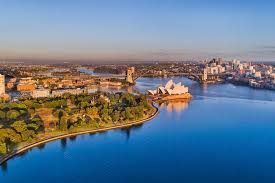Eucalyptus picks
 Koalas are very similar to cute bears, and the name of the species to which these animals belong may suggest that they are relatives of clubfoot. Although in fact, this is completely wrong.
Koalas are very similar to cute bears, and the name of the species to which these animals belong may suggest that they are relatives of clubfoot. Although in fact, this is completely wrong.
Australia is a unique island country spanning an entire continent. It separated from land, including Africa, South America and Australia itself, about 50 million years ago. Over the next 50 million years, this Green Continent, being completely isolated from other parts of the globe, remained in prehistoric prosperity. Charles Darwin, who visited the shores of Australia in 1836 on the Beagle, was extremely amazed to see there the oldest representatives of mammals, living witnesses to the evolution of species – marsupials and ovipositors.
The life span of these animals on Earth is estimated by scientists at 15 million years. Among a considerable number of marsupial animals living in Australia, nobody, even kangaroos, which have become the national symbol of the country, can be compared in popularity with a koala.
At first glance, the koala is very similar to a teddy bear toy. Perhaps due to this similarity, he got his name – marsupial bear (Phascolarctos cinereus).
This typical tree inhabitant is a creature extremely harmless and phlegmatic, having a fairly dense physique. The length of his body does not exceed 60–80, and the height is 30 cm. The weight of the so-called southern koalas reaches 11–12 kg, while among the “northerners” it is almost half that, that is, no more than 5.5 kg. The fur of these animals is quite long, thick and soft, silver-ash color, sometimes with a redhead. The tail is so short that it is almost impossible to make out.
The structural features of the two fingers of the forelimbs and one of the hind limbs allow koalas, deeply piercing sharp claws into the bark of trees and grasping the branches tenaciously, slowly moving from one place to another. The habitat of these animals on Earth is estimated by scientists at 15 million years. More recently, at the end of 2001, Australian paleontologists were fortunate enough to find well-preserved remains of the marsupial lion (Thylacoleo), which is 25 million years old, in the limestone caves of the Riversley State of Klinsland. The last lions died out about 50 thousand years ago. Like other representatives of marsupials, they were carrying cubs in a leather fold located on their stomach. They are the direct ancestors of the current koalas.
Life expectancy of koalas in nature is 12–13 years. Males become sexually mature by 3-4 years old, females – by 2. Upon reaching this age, they begin to create their own families. The male, wanting to attract the attention of the female to his person, rubs against the bark of trees with a special secretory gland located on the chest in the area of a brown spot different from the rest of the skin (it is by its presence that you can visually distinguish males from females), as if applying a liquid secret to your coat with a specific smell. Then the “scented” bridegroom with an inviting guttural “voice” heard at a decent distance declares his desire to marry. And since the number of adult females significantly exceeds the number of males, then this unequivocal proposal is usually accepted at the same time 7-8 females. So potential husbands and get a “harem”.
The female produces offspring once every two years. Pregnancy lasts about 36 days. In a litter, as a rule, there is one, extremely rare – two cubs. Immediately after birth, a koalenka crawls into her mother’s bag – more often, “equipped” with two nipples. In this safe shelter, the baby lives for a total of about 200 days, eating only breast milk for the first 13 weeks. At the age of 22 weeks, the grown animals begin to protrude a muzzle from their bags, getting to know the world around them. After another 2 weeks, the teeth begin to erupt in the cubs, which means that the mother can gradually begin to feed them with eucalyptus leaves.
From 5-6 months, the koalenok begins to get out of the bag and, moving to the mother’s back, spends most of its time there. Finally, he leaves her at 8 months. In rainy and cold weather, the cub is squeezed into the warm coat of the mother, and she, hugging him firmly with her front paws, warms on her chest. Independence comes to the koalats around the end of the first year of life, but for at least another year they prefer to live next to their mother.
Like other marsupials, the hairless and blind koalenok is born extremely tiny. It weighs no more than 5 grams, and the length of his body is only 1.5 cm.
The word “koala” in translation from the language of the aborigines means “not thirsty.”
The composition of eucalyptus leaves, along with essential oil, tannins and phytoncides, includes hydrocyanic acid, which even in small quantities can cause serious poisoning in humans, but its concentration is quite acceptable for koalas.
Koalas are twilight animals. In a drowsy state, they spend 18 hours daily, hiding in the crowns of eucalyptus from prying eyes. At night, they liven up and go to forage.
A large head with furry ears, small sleepy eyes and a shiny round nose make the koala really look like a toy.
For many centuries, in the vast virgin eucalyptus forests of the Green Continent, nothing has disturbed the serene and satisfying existence of koalas. Neither for predators, nor for Aborigines, their meat, literally soaked with essential oils, was absolutely unsuitable. But with the advent of the Europeans to the mainland, their beneficial existence ended.
These extremely slow and gullible animals have become easy prey for a huge number of hunters. In the period from 1908 to 1927 alone, 2 million individuals were destroyed for the extremely valuable fur. Fur coats, hats and toys made from koalas were expensive, but the demand for these products grew day by day. And already after 3-4 years, these animals were on the verge of extinction. Thanks to an active campaign to protect them, a Decree was issued in 1930 prohibiting the hunting of koalas. Wildlife National Parks have also been created. The first of these were Koala Park, located near Sydney, as well as Lone Pine Nature Reserve near Brisbane. It was there that koalas began to live under the reliable protection of the law.
However, today the problem of preservation of these Australian endemic has regained relevance. The fact is that koalas, who prefer a flat climate, always settled along the ocean coast, and the same territories were chosen by people. As a result, over the past 200 years, 80% of all eucalyptus forests in which koalas once lived were destroyed. Such an active attack on the kingdom of koalas of civilization slowly but surely survives these animals from their usual habitats.
Small islands not inhabited by people scattered not far from the mainland become for these poor fellows almost the only refuge. At the same time, this problem has a downside. Active measures taken by the Australians to restore the numbers of these unique marsupial bears have led to a very significant increase in their numbers, which may soon turn into a new tragedy – despite the fact that eucalyptus trees can grow by 12 meters in 4 years, they have become so few that for the feeding of koalas these trees are clearly not enough now. It would seem easier to eliminate a certain number of them by shooting, but activists of the Koalas Rescue Fund, in which about 20 thousand people from several countries of the world take part, are categorically against such measures.
The only way out of this impasse they see in a significant expansion of the landing zones of eucalyptus forests. In the meantime, the biologists who proposed the sterilization of animals took up the matter. The control over the birth rate of koalas has already made it possible to increase the amount of food per animal. Let us hope that this interference in the affairs of Nature is a temporary phenomenon that will allow for the posterity to preserve this sweet and slightly funny creature.
Having eaten all the young leaves and shoots on one tree, the koala descends to the ground, but only in order to move to another. Although sometimes they make longer transitions, for example, to the neighboring eucalyptus forest. It happens that for this they have to cross quite dangerous freeways. And they do it, as, however, and everything else, slowly, absolutely slowly, at the risk of falling under the wheels of passing cars.
The answer to the question of why sloths make such dangerous march-throws when there are other trees nearby, which have long worried Australian scientists, was found recently. The fact is that koalas have a special natural flair that allows them to accurately recognize by smell the increased content of toxic substances in the leaves of specific eucalyptus trees.


